How to check a pinball machine you want to buy
So, you want to buy a pinball machine but don't know much about them? I'll help guide you so you at least have some idea of what to look for. Once you've checked everything, you'll have a better understanding of the game's quality.
Buying a used pinball machine is comparable to buying a used car. You might get lucky and find one that never breaks down—or be unlucky and get one that looks great but constantly malfunctions. Some games are known to have more issues than others. However, on average, a clean, well-maintained game is your best bet.
You're looking for a game that functions well (or needs only minor repairs) but also looks decent. A little dirt is fine; you can clean it yourself. However, aim for minimal wear: not just on paint, but also on components like plastic ramps. Of course, it all depends on your priorities. Maybe you’re not concerned with cosmetics and are perfectly happy with an inexpensive game with a playfield worn down to the wood, as long as the gameplay holds up.
I can’t tell you whether you should or shouldn’t buy a specific game. I can only advise you on what to do. Everything is relative. What are you looking for? A pristine game? Or just one that works, regardless of cosmetic flaws? Your decision ultimately depends on the price. Just don’t pay top dollar for a wreck.
Also, take a look at this other page, which explains how to determine whether a game functions properly.
Play the game
Try to activate all features and evaluate gameplay. Is everything functioning as expected? If a coil stays energized constantly, immediately power off the game and disconnect the coil. Diagnose the issue right away, or you risk burning out the coil!
Only switch on the machine if the owner confirms that it works. Don’t power up a game that's been in storage or whose condition is unknown!
Check the Batteries
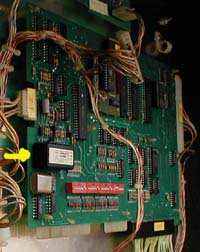
Solid-state games have batteries to retain high scores and settings. Batteries can leak, and leaked batteries are harmful to PCBs. So the first thing to do when buying a pinball machine is to check for battery leakage.
On older Bally/Stern games, the battery is located in the middle of the CPU board (top left corner inside the backbox). Just cut off the battery. Gottlieb games use a DataSentry battery—a black box, indicated by a yellow arrow in pictures—mounted on the left side of the CPU board (top right in the backbox). Unsolder it. Williams games have three AA batteries in a holder. Replace these with new ones.
If any damage of a leaked battery is present, neutralize it with an acid solution and swap out damaged components. Nowadays often reproduction boards are available, which can help rescue games where there is a lot of battery damage. If you’re unfamiliar with electronics, avoid machines with battery damage (unless you want to invest in replacement boards). Games with damage will eventually fail, unless you’re ready to learn repairs or know someone who can help.
Inspect game-specific parts
Generic parts like rubbers are easily replaceable, but game-specific parts can be difficult or expensive to source. Especially in Europe where shipping often costs more than the parts themselves.
Most modern games have unique playfield elements integral to gameplay. Examples include the talking heads in Funhouse and Road Show, or the Path of Adventure in Indiana Jones. While the game might adjust its rules if these features malfunction, you're still missing part of the experience.
Ensure these components are present and functioning. If they’re broken, repairs might be costly and time-consuming, especially if parts are unavailable. Decide whether you're okay with a partially working machine or willing to invest up to another $500 and several months sourcing parts.
Check all plastics
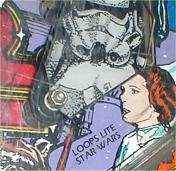
If plastics are cracked or missing, ask yourself: does it bother you? Try to buy a machine in decent cosmetic condition as it holds its value better. But remember, you’re buying it to play.
If it functions well and the price is fair, consider it. Minor chips in corners aren’t a big deal. Replacement plastics are sometimes available online, or you might be able to make them yourself using scans. Slingshot plastics tend to break but are readily available for most games. Other plastics are harder to find and usually sold only in full sets, which can be costly.
Check paint for wear
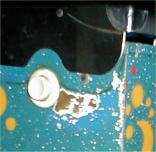
Start with the cabinet. Are there deep scratches or missing paint? If so, can you live with it or touch it up? Then inspect the playfield: ideally it should be spotless or have minimal wear that’s repairable.
Focus on high-wear areas like kickout holes, saucers, jet bumpers, and slingshots. On older games, look for ball swirl marks: fine black lines caused by dirt settling into the paint cracks. These are hard to remove. Do they bother you?
Also check the cabinet near the flipper buttons. The image shows a 30-year-old pinball machine with 70,000 plays. I’ve seen 7-year-old machines with similar wear! Heavy wear implies the game has seen a lot of action, so expect mechanical wear on moving parts.
Inspect Ramps
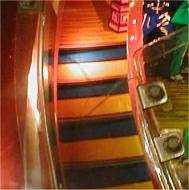
Modern games feature clear plastic ramps. These often crack, especially at entry points and curves. Replacement ramps are expensive and hard to find. You can repair cracked ones or install metal protectors.
Also check ramp clarity. Dirt and wear dull them. Even after cleaning, they may not regain transparency (unless you try to flamepolish them). Decide whether this is acceptable or if you'd prefer a cleaner-looking alternative.
Check score displays
For older games: are displays bright and fully functional? Bally/Stern games rarely have issues and replacements are affordable. Williams System 11 games often have dead displays, which are pricier to fix. Gottlieb blue displays are generally reliable.
For newer DMD-based games: the display must be bright, fully lit, and free of dark or blurry spots. Replacing a DMD is expensive, over $100 in the US, even more in Europe. Poor DMDs may also damage the power board. Missing lines can maybe be solved if they're just bad contacts, dmd's with fuzzy spots have to be replaced or they can stress your power board and damage this too.
I personally avoid machines with faulty DMDs unless I’m getting a discount or the operator agrees to replace it.
Data East games have specific problems which may look like a broken dmd, while it is just a bad fuse or bad resistor. On these games with an extra small display (Checkpoint to Batman), check resistor R95. This is a 33k 1/2 watt resistor.
System11 games with alpha-numeric displays also have a similar problem that often occurs: resistors R1 and R4 on the power supply board often fail. These are 39k ohm 1 watt resistors. When they're broken the displays will not have +/-100 volts. It's best to always replace them, sometimes they don't completely fail but cause your dmd to have missing segments. On WPC games with alphanumeric displays (like Funhouse) these are resistors R48 and R49.
Do the self-tests. All solid state machines have self tests. Check the manual on how to initiate them and what they do. Most of the time you just have to press a button inside the coin door to advance through the tests. Tests will light up all lamps, test the score displays, fire all solenoids, and test all switches. Light bulbs are no problem, these can be changed. Score displays can also be changed, but are more expensive. If they're not or badly working, try to find the price of a replacement part. Or decide if you can live with a game with a bad score display. Listen through the solenoid test if all solenoids are working. Usually their id-number will be shown on the display, check with the manual (or the paper on the inside of the cabinet) which coil has which number. If some are not working, try to find out why ? (loose wire, bad connector, or problem on a pcb ?) If a coil doesn't work, try to move it by hand. If it's hard to move, the coil may be burnt. You'll have to replace the coil, probably the whole assembly (the metal part which goes through the coil, and solve the problem which made the coil burn in the first place. In the switch test, touch every switch and targets to see if it gets activated. Same thing here, if some don't work, try to find out why. They can be worn and need to be replaced, it can be a loose wire, bad connector, or a problem on the pcb. If more then one switch doesn't work, check with the switch matrix in they are in the same row or column, this may give an indication why they all don't work. Replacement targets can be bought, but keep in mind that they may not look the same as the original ones. On recent machines the machine will say which problems it has (like switches not activated) when you open the coin door. This is also indicated by a 'credit dot' (Credits 0.) on Williams/Bally dmd-pins.
Check connectors. Inspect all connectors visually. Check if they have brown burn marks (or are burnt and falling apart when you touch them). On old Bally/Stern pins, check the connectors on the power board (the board with all the fuses). On recent Bally/Williams pins, check the GI (global illumination) connectors (J120 and J121, also check J109, left bottom of the large board in the middle). Replacement connectors are available, maybe you'll have to solder new pins too.. There are known upgrades to do on old bally/stern pins to solve the problem. While burnt connectors aren't a major problem on their own, they are a good indication to know if a machine has been used/powered on for a long time. These problems only happen when a machine is powered on for a long time (all day for months/years). If someone wants to sell a machine as home-use, low play, and has burnt connectors.. then it hasn't been home-use or has been on all day long so HUO doesn't make much of a difference.. It's also an indication that electronic parts may also have been stressed and can fail soon, so if you know nothing of repairing pins, better look for one in a better condition. Also check the pcb's visually (especially the powerboard) to see if they're ok and don't have burn marks on them (and if they do - check closely if the traces are still ok)
Is the game clean ? How clean is the game exactly ? And more specific, look also at the underside of the playfield and the inside of the cabinet. This is also a good indication for the number of games and how well it's been maintained. Beneath a dirty playfield may be a nice one which needs a good cleaning. But you will have to clean the game totally (removing every assembly and cleaning it) or the dirt will come back very soon. Whilst you are cleaning the game, replace all rubbers. Your game will look and play a lot better ! A clean playfield but cabinet which is inside black by the 'pinball dirt', means the previous owner has cleaned the playfield regularly, but the dirty cabinet indicated the game does have a lot of games on it.. If the game is really clean, it really has a low number of plays on it, or someone has already cleaned it very well..
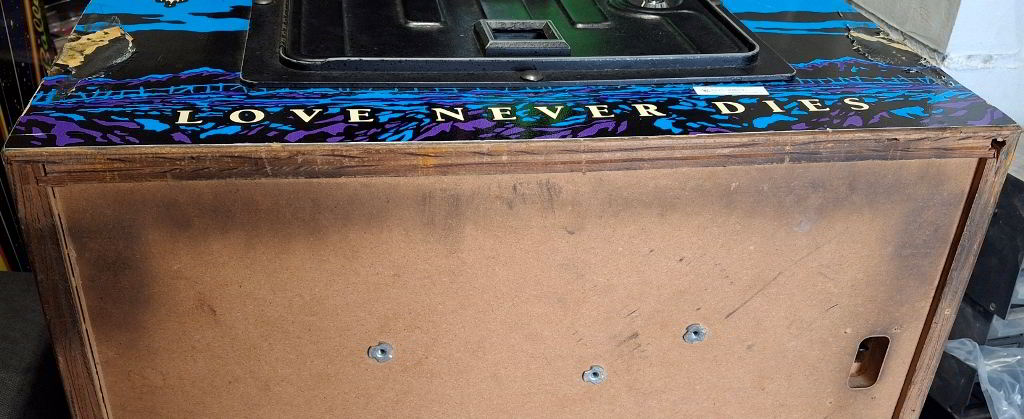
If the bottom edge of the machine is dirty, it's because it's the machine has been lifted a lot, by the operator
who moved it between locations.
Check the backglass. New games have a plastic (translite), older games have a painted glass. Temperature changes and humidity will cause the paint to loose from the glass (flaking). That's a bad sign. Replacement glasses are very difficult to find and can be expensive. A broken or missing backglass is one of the main reasons why most EM pins don't get restored but parted out btw.. you have to be very lucky to find a replacement glass. So if you buy a pin without a backglass, make sure at least the pin is working fine, or it's almost worthless (just for parts).
Buying a game which has been in storage for a long time. Not a lot to say about these ones. Check out where it has been stored and overall condition. Humidity is what you're looking for. If the game has been stored in a dry place and looks good, it'll be fine probably. Check for rust and corrosion on metal parts. EM games may have parts which have become stuck, certainly if someone has been so 'smart' to lubricate them.. Solid State games may have problems with their cpu boards (certainly if the pins of the chips show corrosion !) or leaked batteries. Be careful when you power them up, don't expect them to work from the first time, and they may need a lot of work and replacement parts. Unless they're cosmetically in very great shape, or are rare games, I would not pay a lot for games which have been stored for many years and are not working. Btw, if it's after dusk, have a flashlight nearby when you're going to power up a pin for the first time.. you don't want to search the fuse box in your house in the dark because all fuses blew..)
Do you get any extras. Pinballs machines were shipped with a manual (sometimes even more than one: a game specific manual and general schematics). Do yo get them with the game ? If not, you may want to consider finding out first if you can still acquire a manual, before buying the machine.. Do you get any other replacement parts ? New rubbers are cheap and available, spare coils and game-specific plastics are more interesting to get. Do you have to pick up the game yourself, does it come delivered and installed at your house ? Any warranty ?
If you're looking for pinball parts, then check out Pinballshop.nl (affiliate link).
